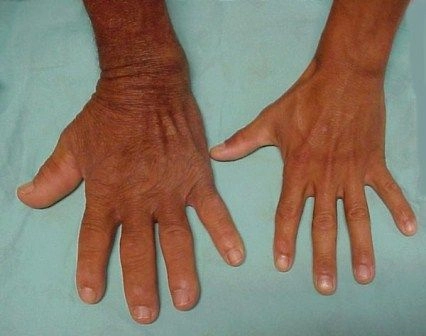How is acromegaly diagnosed?
The clinical diagnosis of acromegaly is typically delayed since the signs of acromegaly are small and take place over the course of many years. Someone who is looking at themselves in the mirror every day may not be able to detect them in real-time.
In addition to a complete medical history and medical examination, diagnostic procedures for acromegaly may include:
- serial photos are taken over the years (to observe physical changes in the patient)
- x-rays (to detect bone thickening)
- blood tests to check the growth hormone (GH) level
Blood tests to diagnose acromegaly
GH and IGF-1 blood tests measure different types of growth hormone levels in your blood. Elevated levels of these hormones in your test results might cause your physician to order a glucose tolerance test to confirm an acromegaly diagnosis. Glucose tolerance tests tell doctors whether your body’s growth hormone levels react to glucose (sugar) the way they should. For this test, you’ll have blood taken at different intervals after you drink a glucose solution.
Observation
Gradual changes to hands, feet, and face.Visible Changes
Noticeably larger facial features, an increase in shoe, glove, or ring size can be indicators of acromegaly.Testing
Tests that can confirm acromegaly diagnosis.Blood Tests
Blood tests for Insulin-like Growth Factor-1 (IGF-1) and a Oral Glucose Tolerance Test (OGTT) can confirm acromegaly diagnoses.
Imaging
Discovery of a tumor, its size, and location.MRI and CT Scans
An MRI is performed on the pituitary gland. If no tumor is present, additional CT scans search in the abdomen and chest.

Visible changes observed
The most common early signs of acromegaly are visual changes to the appearance such as larger hands, feet, and facial features. Most people will not notice these changes on their own unless they need to buy a bigger shoe size to accommodate their larger feet or needing to to size up their ring or gloves due to enlarged hands.
Once physical changes characteristic of acromegaly such as enlarged hands, feet and face have been observed, a combination of tests will be prescribed by your physician. With acromegaly, higher than normal growth hormone levels are present in your blood resulting from persistent overproduction caused by a tumor usually found in the pituitary gland.
Imaging to confirm acromegaly diagnosis
95% of acromegaly cases are caused by pituitary tumors. After testing positively for both the IGF-1 and OGTT tests, your will have an MRI (magnetic resonance imaging) of your pituitary gland. The results of your MRI offer a clear picture of the size and exact location of your tumor.
Sometimes, there is no tumor found in your pituitary gland. If this happens, you may be a rare case of acromegaly that is caused by a non-pituitary tumor. There will be some additional tests and scans. Testing for growth hormone releasing hormone is useful for detecting non-pituitary tumors since they make the GHRH that stimulates growth hormone. Additional CT (computerized tomography) scans will be done on potential tumor sites. The most common secondary of GH stimulating tumors are found in the chest and abdomen.

References:
The Mayo Clinic (2019, November 17) Acromegaly Diagnosis and Treatment [Website]. Retrieved January 2020.
Endicrine Web (1998, December 02) Acromegaly Diagnosis – Blood Tests to Diagnose Acromegaly [Website]. Retrieved January 2020.
The Pituitary Society (2000, October 18) How Acromegaly is Diagnosed | What is Acromegaly? [Website]. Retrieved January 2020.
NCBI (1996, October 18) Clinical Manifestations and Diagnosis of Acromegaly – NCBI [Website]. Retrieved January 2020.
Stanford Healthcare (2014, July 23) Acromegaly Diagnosis [Website]. Retrieved January 2020.
